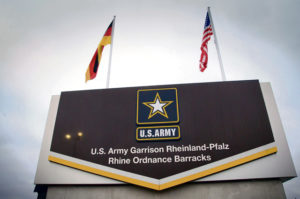
Beds, showers, and a temporary place to call home are three things U.S. Army Garrison Rheinland-Pfalz is providing to people evacuated during Operation Allies Refuge.
The garrison’s contribution is part of a more significant effort by the Kaiserslautern Military Community, which includes Ramstein Air Base, providing a transit point and quarters for evacuees during the crisis. The garrison is providing barracks buildings and on-post space to place tents and other facilities while ensuring safe operations of the Army’s infrastructure necessary to support the mission.
According to the Department of Defense, since Aug. 14, about 37,000 people have been evacuated from Afghanistan. U.S. Transportation Command has more than 200 aircraft dedicated to the effort, and the DOD activated the Civil Air Reserve fleet to assist.
Colonel Vance J. Klosinski, garrison commander, encouraged his garrison directors to do whatever is necessary to facilitate and support Operation Allies Refuge.
“We fully understand there will be hurdles and barriers to our success; however, this is a new mission set for us, and we need to overcome these to meet intent, execution, and be successful,” Klosinski said. “The garrison is a critical component to this mission, and we will be actively engaged.”
Command Sgt. Major Stephen LaRocque is on point for the garrison’s efforts in finding buildings and spaces for evacuees. He said the garrison’s work for Allies Refuge is a fundamental tenet of the work done at all Installation Management Command garrisons.
“We are primarily a facilitator,” he said. “The garrison doesn’t have the manpower and the Soldiers to get after these things, but we can bring groups of people together to get the mission accomplished.”
Garrison directorates focused on preparing the Deployment Readiness Center on Rhine Ordnance Barracks, ensuring the operational capability of utilities, water, and other functions. The garrison also prepared 13 buildings in the Kaiserslautern area, including barracks buildings at the Baumholder Military Community, Miesau Army Depot, and Pulaski Barracks. They have a capacity for about 370 people. Garrison planners also examined spaces for tents, portable toilets, and other facilities in parking lots and empty fields for use.
The Directorate of Family Morale, Welfare, and Recreation is also expanding hours of gyms and other facilities to accommodate Soldiers and civilians tasked to work during the crisis. The Directorate of Emergency services is shuffling police and fire assets to cover the mission.
USAG Rheinland-Pfalz also supports operations at Ramstein Air Base, providing 20 jersey barriers and other assets to the joint operation. Evacuees are initially screened at Ramstein by Landstuhl Regional Medical Center officials, security officials, and others before moving to a temporary home on Ramstein or Rhine Ordnance Barracks.
While the garrison provides facilities, utilities, and services for the effort, the 21st Theater Sustainment Command runs the Army’s side of the local operation, located on Rhine Ordnance Barracks, providing 24/7 management and operations.
In a note to garrison directors, Aug. 22, Michael Amarosa, the deputy to the garrison commander, emphasized the urgency of the crisis to his team.
“There are many moving parts to this mission, and in the end, it is important to understand there are lives at stake as well as their well-being,” Amarosa said. “Think if you or a loved one just went through their experience. This is our mission, a no-fail mission.”
Brig. Gen. Josh Olson, 86th Airlift Wing commander, credited the teamwork between Air Force, Army, and others to the operation’s success so far in a note to his team Aug. 23.
“The preparation, execution, and sustainment of a humanitarian operation this size requires enormous resources, planning, and people. It has been nothing short of incredible to see the outpouring of support from the entire Kaiserslautern Military Community, including thousands of Airmen from all three wings, our Army partners, NGOs, German Polizei, civic leaders, and other host nation partners,” Olsen said.
Operation Allies Refuge is facilitating the “quick, safe evacuation of US citizens, Special Immigrant Visa applicants and other at-risk Afghans from Afghanistan,” according to a US Army Europe and Africa news release. Qualified evacuees are receiving support, such as temporary lodging, food, medical screening and treatment, and more, while housed here and Grafenwoehr, Germany, in preparation for onward movements to their final destinations.
The DOD, in support of the Department of State, is providing additional temporary housing facilities at Fort McCoy, Wisconsin; Fort Bliss, Texas; Joint Base McGuire-Dix-Lakehurst, New Jersey; and Fort Lee, Virginia, for vulnerable Afghans recently brought to the United States.
LaRocque, a veteran of several Afghanistan deployments, said the garrison team is doing worthy work supporting Allies Refuge and creating homes and comfort for evacuees.


